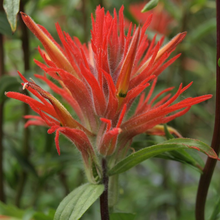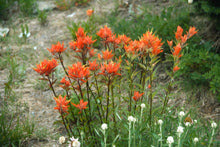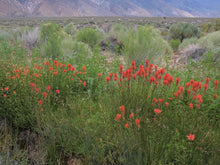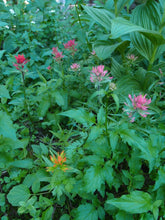
Castilleja miniata
This stunning wildflower is truly one of a kind; adored by hummingbirds, a larval host plant for many species of native butterflies and moths - plus, it’s parasitic (WOW)! It requires an appropriate host to survive and can be challenging to cultivate (details below). Its summer-blooming flower heads stand 1-2ft tall and range from deep red, to pink, and even yellow-orange - yet most of what we see are actually showy bracts obscuring hundreds of tiny, hidden flowers beneath.
- Plant type/canopy layer: deciduous, perennial, herbaceous plant
- Size at maturity: 8"-32" tall, eventually forming clumps ranging in size
- Light requirements: full sun, part sun/part shade
- Moisture requirements: moist to dry soil
- Bloom time: May - September
- Growth rate/ease: moderate growth rate, difficult to cultivate
- Wildlife support: overall plant attracts and supports hummingbirds and is a caterpillar host and larval food source for several species of native butterflies and moths
- Native habitat/range: grows in coastal areas, meadows, moist riverbanks, and alpine forests from Alaska to California and east to the Rocky Mountains and Ontario, Canada. Portland Plant List - no.
- Special features & uses: Gitksan, Nitinaht, and Nlaka'pamux Pacific Northwest peoples traditionally use a decoction of the entire plant to treat bleeding lungs, sore eyes, and backaches, as a diuretic and as a purgative. A decoction of seeds can be used as a cough medicine. The nectar can be eaten as candy. Excellent as a cut flower or the broken parts used in decorations.
Gardening with Giant Red Paintbrush: Since this is both a hummingbird magnet and a larval host plant, red paintbrush is best in a pollinator garden or meadowscape. As a parasite, it needs to plug its root system into the roots of various hosts, extracting nutrients that supplement its growth - without entirely depleting the nutrients from the host plant. Known hosts include, but are not limited to, Roemer’s fescue, yarrow, Oregon sunshine, thimbleberry, and even some non-native weeds such as oxeye daisy. Plant paintbrush in the same hole as its host, trying to gently intermingle the roots. Or, cut back an established host already in your garden and carve a planting hole directly into the host crown. With this complicated host dependency, this plant can be challenging to establish. Consider buying in multiples to increase the chances of success.
Photo Credit 1: "meadow paintbrush, Castilleja miniata subsp. miniata" by Jim Morefield is licensed under CC BY-SA 2.0
Photo Credit 2: "Castilleja miniata" by mmmavocado is licensed under CC BY 2.0
Photo Credit 3: "meadow paintbrush, Castilleja miniata subsp. miniata" by Jim Morefield is licensed under CC BY-SA 2.0
Photo Credit 4: Nikkie West, Sparrowhawk Native Plants







